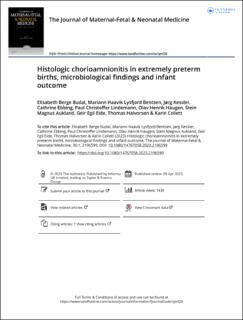| dc.description.abstract | Background: Histologic chorioamnionitis (HCA) is most often caused by ascending bacterial infection originating from the cervicovaginal tract.
Objectives: To investigate whether HCA with a fetal inflammatory response (FIR) has a worse clinical outcome than HCA alone. Further, if FIR or a positive maternal microbiologic culture obtained prior to birth were related to adverse neonatal outcomes in a cohort of extremely preterm (EP) neonates.
Methods: Prospective observational cohort study recruiting EP singleton pregnancies (gestational age at birth ≤28 weeks) with confirmed HCA. FIR was defined by fetal neutrophils in the chorionic vessels and/or umbilical vessels. Positive culture was defined as growth of potentially pathogenic bacteria in a sample from the cervicovaginal tract prior to birth, or if a cervicovaginal culture was lacking, a culture result from the placenta was used. Logistic regression was used to estimate odds ratios and 95% confidence intervals for the associations between FIR, a positive culture result and adverse outcomes, defined as bronchopulmonary dysplasia (BPD), brain pathology assessed by magnetic resonance imaging, retinopathy of prematurity, necrotizing enterocolitis, early-onset neonatal sepsis, and perinatal death. A composite outcome variable included one or more adverse outcomes.
Results: We included 71 cases with HCA, of which 51 (72%) had FIR. Maternal age, rate of clinical chorioamnionitis (CCA), preterm pre-labor rupture of membranes (PPROM), the number of women receiving antenatal steroids and antibiotics, and the rate of positive maternal cultures of potentially pathogenic bacteria were all significantly higher in the HCA with FIR. Neonates in the FIR group had significantly higher levels of blood leukocytes compared to those without. FIR was associated with a longer interval from PPROM to delivery (log-rank test: p = .022). Microbiological sampling had been performed in 63 (89%) cases, of which 60 (95%) were cervicovaginal samples. No associations were found between a positive culture and adverse neonatal outcomes, in contrast to FIR, that was significantly associated to BPD and brain pathology.
Conclusions: In a cohort of EP pregnancies with confirmed HCA, the presence of FIR was associated with advanced maternal age, CCA, PPROM, antenatal steroids and antibiotics, and a positive maternal culture of potentially pathogenic bacteria. However, the presence of FIR, and not a positive culture, was associated with adverse neonatal outcomes. | en_US |

